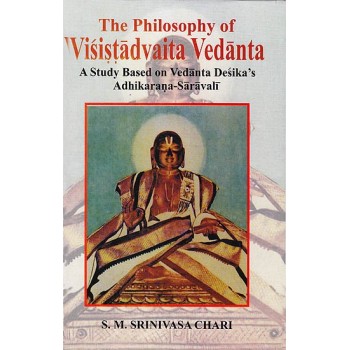The Philosophy of Visistadvaita Vedanta
| Price: | Rs.995.00 |
Detail Of The Philosophy of Visistadvaita Vedanta
| ISBN | 9788120831803 |
| Pages | 436 |
| Language: | English |
| Product Code: | 1 |
| Size(in cm): | 8.8 inch X 5.8 inch cm |
| Weight(in grams): | 680(approx) |
Description:
Contents
Foreword xiii
Preface xv
Abbreviations xviii
Introduction xix
Chapter One The Study of Vedanta 1
I. Brahma-jijnasa 2
II. Purva-mimamsa and Uttara-mimamsa 3
III. Definition of Brahman 12
IV. Proof for the Existence of Brahman 19
V. The Upanisads and Brahman 20
Chapter Two The Doctrine of Brahman 27
I. Brahman as Sentient Being 27
II. Brahman as Anandamaya 31
III. Brahman as Endowed with Spiritual Body 36
IV. Brahman as Distinct from Non-sentient Cosmic Entities 39
a. Akasa as Brahman 40
b. Prana as Brahman 41
c. Jyotis as Brahman 42
V. Brahman as Antaratma of Indra-Prana 44
Chapter Three The Distinguishing Characteristics 53
I. Brahman as the Self of All 55
II. Brahman as the Devourer of the Universe 58
III. Brahman as the Purusa Abiding in the Eye 61
IV. Brahman as the Inner Controller of All 65
V. Brahman as the Imperishable Reality (Aksara) 69
VI. Brahman as Vaisvanara 71
VII. Brahman as the Ayatana of Heaven and Earth 74
VIII. Brahman as Infinitely Great (Bhuma) 77
IX. Brahmana conceived as Aksara is the Adhara of the Universe (Visvadhara) 80
X. Brahman as the Object of Enjoyment for Muktas 84
XI. Brahman as the Subtle Space within the Heart (Daharakasa) 86
XII. Brahman as Angusthamatra Purusa is Sarvaniyanta 91
XIII. Brahman as the Object of Meditation for Devatas 93
XIV. Brahman as the Nama—rupa Nirvahita 95
Chapter Four Brahman as the Cause of the Universe 101
I. Avyakta conceived as Prakrti is not the Cause of the Universe 103
II. Aja conceived as Prakrti is not the Cause of the Universe 105
III. The term Panca-panca—jana does not imply Samkhya Theory of Prakrti and its Evolutes 107
IV. Avyakrta as Prakrti is not the Cause of the Universe 109
V. Purusa as Jiva is not the Cause of the Universe 111
VI. Atman conceived as Mukta-purusa is not the Cause of the Universe 115
VII. Isvara conceived by yoga school cannot be the Cause of the Universe 119
VIII. Brahman as the Supreme Deity is the Cause of the Universe 120
Chapter Five The Doctrine of Universe and Brahman 123
I. Brahman as the Material Cause of the Universe 123
II. The Relation of Bral1m.1n lo the Universe 129
III. The Universe as an Integral Part of Brahman 133
IV. Refutation of objections against the Theory of Brahman as the Upadana Karana 136
a. The Smrti Texts of Samkhya and Yoga are opposed to Vedanta 137
b. The Cause and Effect are of different nature 138
c. Brahman is not subject fo the experience of pleasure and pain 140
d. Brahman as the Creator of the Universe is not affected by the afflictions of the Universe 141
e. Brahman is not in need of Accessories for Creation of the Universe 142
f. Brahman does not transform itself into the Universe 143
g. The Purpose of Creation of the Universe 145
Chapter Six The Theory of Cosmic Creation 149
I. The Samkhya Theory of Cosmic Evolution 150
II. Vaisesika Theory of Cosmic Creation 154
III. Buddhist Theories of Cosmic Origin 156
a. Vaibhasika Theory 156
b. Sautrantika Theory 157
c. The Theory of Yogacara 159
d. Madhyamika Theory 162
IV. Jaina Theory of Universe 165
V. The Theory of Pasupata 168
VI. The Theory of Pancaratra 169
VII. The Ontological status of the Evolutes of Prakrti 171
VIII. The Process of Formation of the Physical Universe 177
Chapter Seven The Doctrine of Jiva and Brahman 181
I. Jiva as Eternal (Nitya) 183
II. Jiva as Jnata 184
III. Jiva as Karta 188
IV. The Dependence of Jivatman on Paramatman 191
V. The Relation of Jiva to Brahman 195
VI. The Theory of Transmigration of Jiva 201
VII. Four States of Jiva 210
a. State of dream 210
b. State of susupti 211
c. State of swoon 213
Chapter Eight The Doctrine or Sadhana 217
I. Brahman as the Object of Meditation 217
a. Brahman as Ubhayahlinga 217
b. Brahman as the Supreme Being 225
c. Brahman as the Bestower of Moksa 227
II. The Theory of Brahma—Vidya 228
III. Karma as Subsidiary means to Vidya 238
IV. The Nature of Vidya (Upasana) 245
Chapter Nine The Doctrine of Parama Purusartha 257
I. The Nature of Liberation of the Jiva from Bondage 257
II. The Theory of Exit of the Jiva from the Body 261
III. The Theory of Arciradi—marga 273
IV. The Goal of Attainment by Jiva 276
V. The Nature of the Supreme Goal 283
a. The Nature of Attainment by Jiva in the State of Mukti 283
b. The Manner in which the Jiva enjoys Brahman 286
c. The Specific Form in which Jiva manifests in the State of Mukti 290
VI. The Status of Jiva with Brahman in the State of Mukti 292
Chapter Ten General Evaluation and Conclusion 303
I. Nature of Brahman 313
II. Brahman as the Upadana-karana 318
III. The Theory of Jivatman 323
IV. The relation of Jiva and Universe to Brahman 325
V. The Causal Relation of Universe to Brahman 331
Appendix I: The Names of the Adhikaranas 339
Appendix II: The Names of the Brahma-Vidyas 373
Glossary 375
Bibliography 391
Index 395
Reviews (0)
Write a review
Your Name:Your Review:
Note: HTML is not translated!
Rating: Bad Good
Enter the code in the box below:
Recently Viewed



 |
| 

